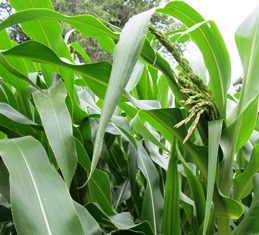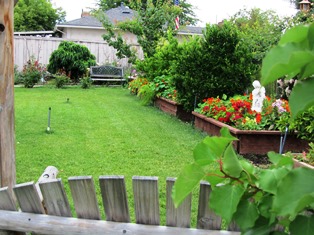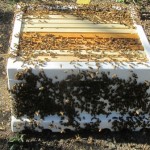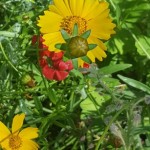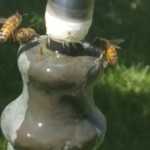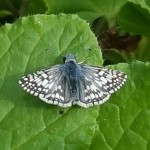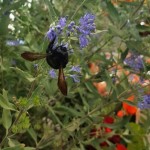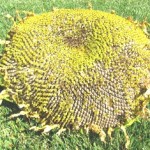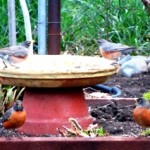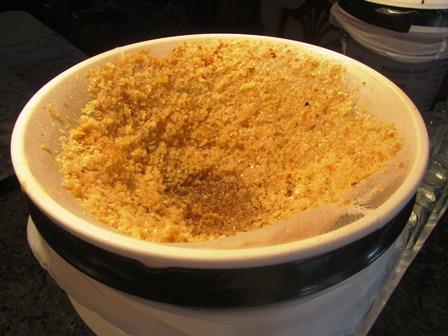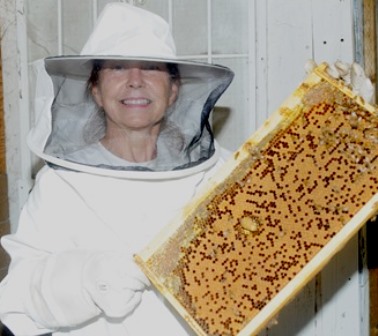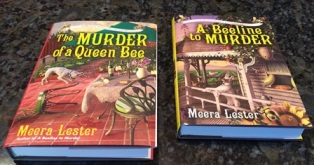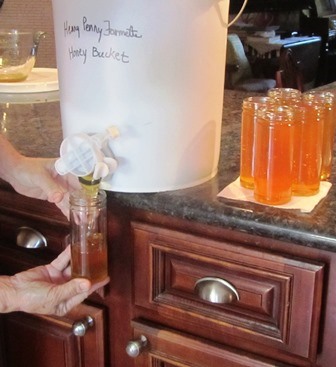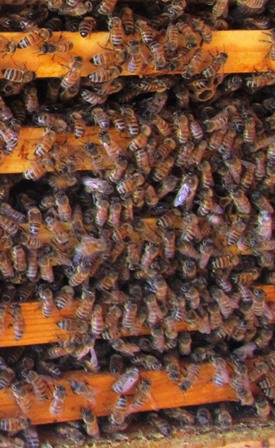Archive for the 'Honeybees' Category
Edible Landscape: Our Garden of Gentle Disorder
I’ve long been enamored of the traditional French jardin potager or ornamental, vegetable kitchen garden. The kitchen garden has its roots the medieval jardin de curé, described by garden author Jean-Paul Collaert in Kitchen Gardens of France, by Louisa James (Thames and Hudson 1999), as a “garden of lines . . . not dabs of color” as opposed to the English cottage garden and the traditional vicarage garden.
Most potagers grow the traditional four types of plants: vegetables, fruit, flowers, and herbs. What I love is the revival of interest worldwide in heirloom fruits and vegetables, which are perfectly suited for a kitchen garden. On my farmette, I grow plants almost exclusively from heirloom seed.

Corn, cucumber, and tomatoes share ground space; onions, garden peas, and eggplants thrive in boxes, table grapes spill over the fence
The medieval jardin de curé has been characterized by scholars as having plants in distinct beds laid out along formal lines (the Latin cross was popular). Gardening plots were defined by ge0metric shapes that could be quite complex (for example, the historic knot garden). Plants included herbs and flowers (many for medicinal uses), vegetables, berries, fruit trees, and ornamental trees and shrubs. This type of garden could be rustic or highly formal and could be found throughout France, from small farms and cloisters to country estates.
Our farmette garden has characteristics of the jardin potager and also the jardin de curé, although it could not be described as a true representation of either.
When we first moved to the farmette, we created and followed a master plan. The acreage follows a large rectangular-shape perimeter with our small house situated in the middle. Behind the house, a lawn is lined with gravel pathways. The pathways are dotted with boxes of herbs and flowers, mint, and berries. Between the boxes, the apricot, cherry, apple, fig, and persimmon trees are flourishing and producing bountiful crops.
In chaotic disorder, the beds of French perfume lavender and Spanish lavender that we planted have taken over one side of the property (much to the delight our honeybees), effectively erasing any lines that might have been obvious in an early layout. Interspersed with the lavender beds are iris, hydrangea, roses, lemon trees. Where the lavender turns a corner, bamboo creates a privacy screen, and then the fruit and flower-lined gravel path continues to the chicken house.
We moved dirt from the back half of the property and built a retaining wall along an L-shaped gravel path leading to a vegetable garden. Both sides of the path are lined with trees–apricot, pear, and pomegranate. On one side under a massive elm is a bed containing white geraniums and a variety of rose bushes.
We are following a plan for our own vision of a potager and, although I wish it had more of the lines of the medieval jardin de curé, our garden has the appearance of gentle disorder while being a prolific producer, in short, an edible landscape.
I love this living tableau. The appearance of the garden and grounds changes with the cycles of the seasons. Also ever-changing are the types of wildlife and songbirds frequenting the fountains and foraging on the fruits. There’s always something new to discover.
__________________________________________________________________
If you enjoy reading about farmette topics, gardening, and keeping chickens and honeybees, check out my series of cozy mysteries from Kensington Publishing in New York. Click on the link.
A HIVE OF HOMICIDES
A Hive of Homicides or Hive Demise
The title of the third novel in my Henny Penny Farmette series suggests loss of bees and murderous intent. No beekeeper wants to lose a hive, regardless of how it happens–whether some invader wants to kill the bees, go after the honey, or use the hive as a host for proliferation of its own species.
I’m not one-hundred percent positive why I lost a hive this year. My best guess was that the demise was due (not to homicide but rather) to a tiny little pest, possibly a beetle that weakened it so that the bees and queen fled leading to the hive’s demise.
My beekeeper neighbor and I spotted a small beetle and treated for it. My best efforts to keep my small bee house and the area around it clean as well as doing frequent hive inspections wasn’t enough. Now, I’m considering moving my remaining hive onto a higher, drier, sunnier location.
I’ll do it at night which is the correct time to move bees. You just put a little strip of packing foam along the hive entrance, gently move the hive, and place it in the new location. Remove the foam strip so the bees can leave at dawn and make sure there’s a water source nearby.
The bees will likely accept the move if there is water and food in the area. I like planting perennial bee gardens and flowers and bulbs with high nectar value for bloom throughout the year.
Since hives can be compromised by wax moths, hive beetles, and other pests (as well as parasites and diseases), frequent inspections to decipher a problem and treat it before it destroys your hive is imperative.
With supers (smaller hive boxes with ten frames each) on the hive in June, the bees will forage on abundant flowers and produce honey that can be taken off in July. That’s also the time to inspect for mites because these populations tend to swell during summer.
________________________________________________________________
If you’re interested in beekeeping and other farmette topics, check out my Henny Penny Farmette series of mysteries. All are available to order online at Amazon, Barnes and Noble, and other retailer sites as well as traditional bookstores everywhere.
Plant for the Pollinators
I seldom need an occasion to put in another bed of flowers, but this is National Pollinator Week. I think a new bed is in order to attract local bees, birds, bats, and butterflies–all considered pollinators. Having these small creatures around benefits landscapes, gardens, and orchards.
The U.S. Fish and Wildlife Service has noted that over 75 percent of our plants are pollinated by birds, animals, and insects. We can help ensure these creatures will be around for a long time if we restore their habitats and ensure they have food and water.
There are many lovely plants you can grow that don’t require a lot of care.
- lavender
- bee balm
- echinacea
- sage
- cilantro
- thyme
- sunflowers
- sweet alyssum
- anemone
- borage
- geraniums
- scented pelargoniums
- mint
A tapestry of colorful herbs and flowers beautifies your landscape and pollinators love the diversity. If you don’t have a lot of space, grow some of these plants in planter boxes, clay pots, or other types of containers.
Put in a water feature, too, such as a table-top or larger fountain that recycles water. Even a pottery saucer filled each day can attract pollinators.
It won’t take long for the bees and hummingbirds to find the water. Their frequent visits are fun to watch, and they’ll likely be sipping throughout the day.
_________________________________________________________________________
If you enjoy reading about farmette topics, check out my Henny Penny Farmette series of cozy mysteries from Kensington Publishing. My newest novel includes delicious recipes, tips on keeping bees and chickens, and much more. Click on this URL for more information, http://tinyurl.com/ya5vhhpm
.
Cold Weather Means Protecting Citrus, Covering Hives
It’s hard to believe Thanksgiving is next week and already, the first snows have arrived in the Sierras and Rockies.

The water in our Italian fountain froze overnight and now the birds and bees that drink there must wait for the sun to melt the ice.
The plunge of nighttime temperatures here on the Henny Penny Farmette are hovering at frost and freezing levels. This morning, I walked with a steaming cup of coffee and noticed the thermometer hovering at 39 degrees Fahrenheit. That means our citrus trees and other frost-intolerant plants must be protected or moved indoors.
The work I’ve been bearing down on–a new book, mystery promo, and prep for Thanksgiving–now have to be put aside for a few hours. I’ve got plenty of cold-weather work to do outside.
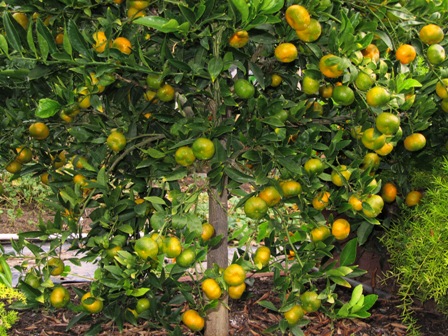
Our Satsuma mandarin orange tree prolifically bears fruit this time of year but is susceptible to freeze
Citrus trees will be covered with blankets against the frost. I’m hanging the heat lamp in my chicken house. I need to clean the chicken house, put more straw in the nesting boxes, and a ground corncob material on the floor. Already, I’ve put the windows back in (leaving a crack open for ventilation).
I opened the beehives last weekend and added an extension onto one hive–something not normally done during autumn when you typically shrink the size of your hives. The hive seemed overpopulated and the bees seemed stressed. After closing that hive, I wrapped both of them with blankets.
With the the citrus protected, the heat lamp in the chicken house, and the beehives covered, I can return to my indoor work . . . it never stops but my passion has always been to live close to the earth and write. This is the good life, made better by this wonderful Mediterranean-like climate that enable our citrus and grapes to thrive (although plunging temps make for a little extra work protecting them).
* * *
Enjoy reading about farming topics? Check out my cozy mysteries–A BEELINE TO MURDER and also THE MURDER OF A QUEEN BEE (both in the Henny Penny Farmette series from Kensington Publishing).
These novels are chocked full of recipes, farming tips, chicken and beekeeping tips, sayings and, of course, a charming cozy mystery. For more info, click on the links under the pictures.
The books are available through online retailers such as Amazon, Barnes & Noble, Kobo Books, and Walmart as well as from traditional bookstores everywhere.
See, http://tinyurl.com/hxy3s8q
This debut novel launched the Henny Penny Farmette series of mysteries and sold out its first press run. It’s now available in mass market paperback and other formats.
See, http://tinyurl.com/h4kou4g
NEWLY RELEASED! This, the second cozy mystery in the Henny Penny Farmette series, is garnering great reviews from readers and industry publications.
First the Harvest, then the Floor
My kitchen floor was littered with bits of wax and bee glue yesterday. It took me over an hour on my knees to scrub and clean it after I had uncapped thirty frames of honey I’d taken from my hives.
In the process of scraping each frame and then unsealing all the capped cells on the front and back of each frame, drops of wax and propolis, or bee glue (created by the bees from bee saliva, wax, and exudate from botanical sources) fell to the floor. I tracked it from the counter, sink, and extractor on the soles of my shoes.
Even before I put my honey buckets under the extractor spigot, I tape fine mesh strainers over the buckets to catch wax and other debris.
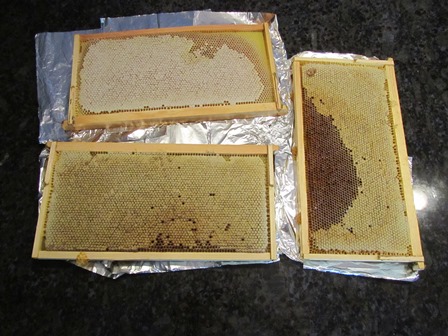
Three frames containing honey, but the sweet stuff is locked inside a honeycomb of cells sealed with wax by the bees
Once all the frames are processed and the buckets are sealed, I put the wax I’ve removed from the frames into a mesh bag to drain the honey (usually a much smaller quantity of honey is recovered from this process).
When the honey has been removed from the mesh bag, I place that wax on a cookie sheet and set it in the garden for the bees to clean. After the bees have cleaned all the wax (by eating any drops of honey left), I save the wax to melt into bars for candles or soap-making.
Back in in the kitchen, the extractor, it must be washed inside and out. Once cleaned and moved to the patio, I must start removing the wax and propolis from the floor. For that, I use an old thin, metal spatula to scrape the tile free of wax.
A soap and water scrub follows. Then I rinse and dry the floor with rags before moving the honey extractor back into the kitchen.
I won’t take honey again until next year. But now the honey must be bottled–that means I must sterilize bottles and prepare labels. Keeping honeybees is really only this labor intensive during and after the honey harvest. But the harvest is well worth all the work.
If you enjoy reading about farmette topics (including gardening, beekeeping, and delicious recipes), check out my cozy mysteries A BEELINE TO MURDER and also THE MURDER OF A QUEEN BEE in the Henny Penny Farmette series (from Kensington Publishing).
* * *
Enjoy reading about farming topics? Check out my cozy mysteries–A BEELINE TO MURDER and also THE MURDER OF A QUEEN BEE (both in the Henny Penny Farmette series from Kensington Publishing).
These novels are chocked full of recipes, farming tips, chicken and beekeeping tips, sayings and, of course, a charming cozy mystery. For more info, click on the links under the pictures.
The books are available through online retailers such as Amazon, Barnes & Noble, Kobo Books, and Walmart as well as from traditional bookstores everywhere.
See, http://tinyurl.com/hxy3s8q
This debut novel launched the Henny Penny Farmette series of mysteries and sold out its first press run. It’s now available in mass market paperback and other formats.
See, http://tinyurl.com/h4kou4g
NEWLY RELEASED! This, the second cozy mystery in the Henny Penny Farmette series, is garnering great reviews from readers and industry publications.
Harvesting Honey–A Labor of Love
Sitting in the middle of my kitchen is a three-story hive box with thirty frames of honey that needs to be extracted, filtered, and poured into jars.
My apiary is small–just two hives. Taking the honey is quite a labor-intensive activity. But it brings its own kind of joy. As pollinator populations decrease, keeping bees is a small thing I can do for all of us . . . for our planet.
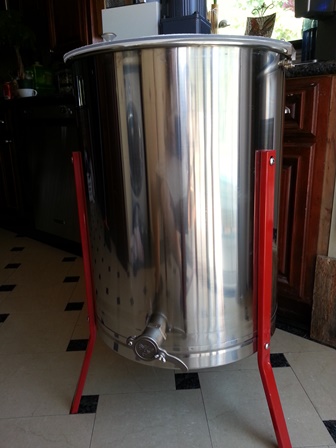
This electric honey extractor holds four frames; honey is spun out through centrifugal force and drains through the spigot
The stainless steel honey extractor, washed and scrubbed, has been pushed over by the oven to make a little space in my already-small kitchen.
Today, I washed the countertops, my stove, and even the sink with hot soapy water and bleach. Then after a thorough wipe-down, I stretched sheets of aluminum foil over the countertop. The extraction process started with four frames.
It’s a simple process. I set the four frames of honey on the foil-covered counter. Using a hot knife, I open the capped cells on both sides of the frames and put them in the honey extractor. Beneath the machine’s spigot, I’ve already positioned a five-gallon bucket with strainer attached. I start the machine on a slow speed and open the spigot.
Each of the five gallon and two-gallon buckets were previously washed and covered with strainers. These are held in place with heavy duty duct tape wrapped around the mouths. Switching out a full bucket for an empty one is easy when the buckets are prepped for use before the extraction starts.

Springtime honey appears golden in the frames whereas autumn honey is often darker (depending on what’s flowering, but often star thistle and eucalyptus, in my area)
I expect a yield of about thirty-five gallons this time. I lost one hive . . . more on that later, but, in all, it looks to be a good honey harvest for our family and friends.
As soon as I extract all the honey, I’ll start bottling it and affixing labels. It’s a process that will take several days to complete.
Tasting, smelling, and seeing all this golden, delicious honey that the bees created warms my heart. When we take care of them, they take care of us. And we always leave plenty of honey in the hives for the bees to eat throughout the winter.
* * *
If you enjoy reading about farmette topics (including gardening, beekeeping, and delicious recipes), check out my Henny Penny Farmette cozy mysteries series from Kensington Publishing.
These novels are chocked full of recipes, farming tips, and sayings as well as a charming cozy mystery.
See, http://tinyurl.com/hxy3s8q
This debut novel launched the Henny Penny Farmette series of mysteries and sold out its first press run. It’s now available in mass market paperback and other formats.
See, http://tinyurl.com/h4kou4g
JUST RELEASED! This, the second cozy mystery in the Henny Penny Farmette series, is garnering great reviews from readers and industry publications.
My books are available through online retailers such as Amazon, Barnes & Noble, Kobo Books, and Walmart as well as from traditional bookstores everywhere.
The Murder of a Queen Bee–Reviews
I love it when the reviews start rolling in for one of my novels . . . in this case, THE MURDER OF A QUEEN BEE. Here’s a highlight of the Booklist review to be published in that magazine’s September 1, 2016 issue:
“Framed with details of beekeeping, herb growing, and living and working on a small farm in California, this charming cozy also includes well-drawn, engaging
characters and a promising new romance for Abby.”–Sue O’Brien
For more than a century, Booklist magazine has been and continues to be the go-to resource for American librarians (see, http://www.ala.org/offices/publishing/booklist/).
As libraries develop and evolve their collections of all types of library materials for virtually every genre and age group, they depend on reviews that Booklist provides. As an author, I appreciate having positive reviews from respected publications such as Booklist and Kirkus as well as other media in their respective platforms. As a cozy author, I also appreciate the exposure my novels get on blogging sites and other social media platforms.
* * *
Publisher’s Weekly, a major industry magazine that reviews books had this to say in its August 29, 2016 issue regarding THE MURDER OF A QUEEN BEE by Meera Lester (Kensington HC/October 2016/978-1-61773-913-2)
“Lester ticks all the boxes…This one is for lovers of cozy mysteries that are heavy on the cozy.” – Publishers Weekly
I’m also thrilled that Kirkus Review (see, https://www.kirkusreviews.com/), a valuable industry-firsts reviewing resource since 1933, has offered a review of my forthcoming novel, THE MURDER OF A QUEEN BEE that includes an excellent plot summary and this take-away quote about my protagonist ex-cop Abigail Mackenzie:
“Abby naturally finds it hard to concentrate on murder while she’s trying to decide what to do about Clay and her newfound attraction to Jack. The second from Lester (A Beeline To Murder, 2016) is long on romance, sweet tips, and honey recipes. . . . [and] mystery, too.”
The Murder of a Queen Bee, byLester, Meera
312 p. Kensington, hardcover, $25. (9781617739132)
E-book, $11.99. (9781617739149).
These novels are available through online retailers such as Amazon, Barnes & Noble, Kobo Books, and Walmart as well as from traditional bookstores everywhere.
See, http://tinyurl.com/hxy3s8q
Now available in mass market paperback, this debut novel launched the Henny Penny Farmette series of mysteries and sold out its first press run.
See, http://tinyurl.com/h4kou4g
The second cozy mystery in the Henny Penny Farmette series, available Sept. 27, 2016, is now available on Net Galley (netgalley.com) for professionals and readers who write reviews.
A Good Day to Strain, Drain, and Bottle Honey
It’s Sunday. I’m bottling the honey that I pulled from the hives last week. Yesterday, I washed two dozen eight-ounce jars in the dishwasher and allowed them to dry upside down on paper towels. Today, I’ll put on my apron and listen to some energetic big band tunes while I drain that honey into jars.
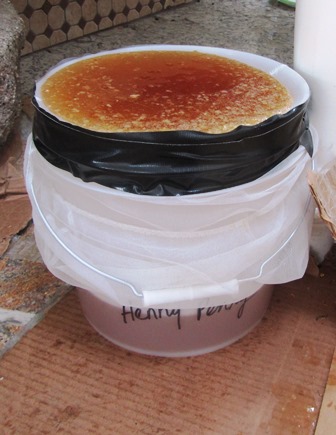
The fine mesh strainer taped tightly around the bucket rim traps the bits of wax but does not impede the flow of honey
My buckets of honey still have duct tape around their rims holding the strainers in position. When the honey was spun in the extracting machine, it had to be drained through a filter. Painter’s filters work great as the mesh cloth is very fine and fits over the top of the bucket.
The filter is placed into position around the rim and then duct taped is wrapped around tightly two times. Honey is quite heavy and can pull down the filter if not secured. I’m straining the honey that goes into jars. However, I did save back a jar of unfiltered honey with all those bits in it for a family member who prefers it that way.
The work was easier and went faster than I’d expected. It helps to have everything you need close at hand, clean, and ready to go.
Of the three large buckets, the first had a nice spigot than I could turn off after I allowed honey to flow and fill the jar. Then I closed the spigot, wiped the jar with a damp paper towel, and then screwed the lid in place.
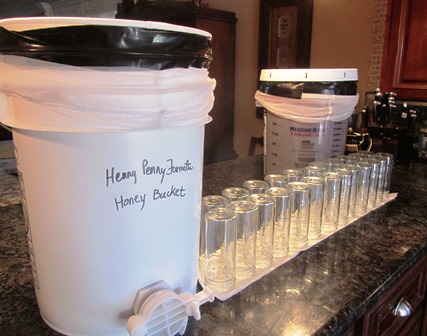
This five-gallon honey bucket will fill approximately five dozen eight-ounce jars; pictured here are 24 jars
The two dozen eight-ounce jars barely made a dent in my first honey bucket although my neighbor tells me that I can easily fill five dozen of the eight-ounce jars from one five-gallon bucket; or, I can fill two and one-half dozen of the sixteen-ounce jars.

Filled jars reveal clear, light amber honey the bees made from the French perfume lavender on my farmette and our springtime flowers, but these jars still labels
The next step in the process is to affix my Henny Penny label onto the jar. I plan to give some of these jars away during promotions in early October for my forthcoming novel, A BEELINE TO MURDER, the first in the Henny Penny Farmette series of cozies.
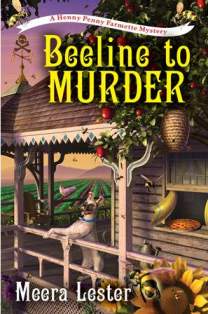
Published next month by Kensington, my book is available on Amazon, Barnes & Noble, and through most booksellers and online bookstores
If you are interested in this honey, please feel free to email me at meeralester1@gmail.com.
Scientific Studies Show Negative Effects of NeoNics
Neonicotinoids, commonly referred to as neonics, are a new class of pesticides that are closely related to nicotine. As the U.S. government debates the use of these controversial chemicals and studies go on, the European Union has voted to ban bee-harming pesticides. See, http://www.theguardian.com/environment/2013/apr/29/bee-harming-pesticides-banned-europe.
There’s no question that the bee population has been in decline in the last decade. Many beekeepers and experts alike have been vocal in their suspicions that exposure to neonicotinoid pesticides is a likely culprit. The journal Nature published a study that revealed significant negative effects on the wild bumble bee foraging on plants sprayed with the new class of pesticides.
Pollinators of all types are important to our food crops, but especially the bumble bees and honeybees. The latter are trucked around to farms and orchards (particularly the almond orchards) in early spring to pollinate the blossoms.
Exposure to neonicotinoid pesticides resulted in wild bees doing less reproducing, having smaller colonies, and having colonies that didn’t grow as compared to wild bees not exposed to the neonics.
One of the studies was the result of research done in the wild, using 16 patches of land divided into two parcels of eight patches each. One area used canola seeds coated with the pesticide containing neonics. The seeds were not coated in the other area.
Scientists then compared the bees exposed to the pesticide with bees not exposed. The treated side had half as many bees per square meter as the untreated side. The bees in the pesticide patches also had negligible weight gain, but the bees in the untreated area gained roughly one pound.
Neonicotinoids are now the world’s most widely used pesticides. Isn’t it time farmers of the world found other options and chemical companies put less money into lobbying for these bee-dangerous chemicals and instead searched for good alternatives to help farmers deal with pests in their fields and orchards?
Sixty Pounds of Honey, Death of Some Drones, and a New Swarm
I opened my hives this past Sunday with the help of my world-class beekeeper neighbor. We checked on the the condition of eggs, the number of new queens, the growth of baby bees, the presence of mites (none detected), and the amount of honey (lots).
The male bees (the drones) over the last weeks have been engaged in some crazy flight patterns in front of the hive as the mating of the queen takes place. The old queen has done her egg laying and the hives have lots of babies with nurse maids and other worker bees. From the hives comes the clearly audible sound of humming and the fragrant scent of honey.

The drone (male bees) are vital for mating with the queen; after that, they are unnecessary and are eliminated
The drones are not now needed and the workers in the colony are doing away with them. I found a stack of drones at the front door of the hive this morning. Strange sight to see, indeed. But no more so than the many queen houses (formed from honeycomb by the worker bees). These houses are where the new queens are nourished; each contains royal jelly.
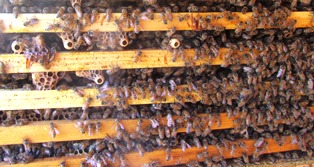
The tubular circles are the houses where the baby queens will be cared for by the workers. The houses contain royal jelly for the feeding of the new queens
My neighbor told me to wait three more weeks to take honey, but since I didn’t take any honey during the fall/winter and there were huge stores of it in my hives and coupled with the fact that there’s a plethora of flowers now to provide pollen for the bees, we decided it would be okay to remove some frames. So, I took six frames (weighing roughly ten pounds each) from the hives.
The honey I harvested has a pale lemony color–significant for the wildflowers and almond and fruit tree blossoms from which the bees collected the pollen to make that honey. In the fall, the honey is darker and earthier tasting, thanks to pollen from the star thistle and eucalyptus blooms.
When we had finished with my hives and walked back to my neighbor’s house, we spotted a swarm overhead. We grabbed the pots and wooden spoons and started banging. The bees took refuge in the tall pepper tree and that’s where my neighbor rescued them. In all, it was quite a spectacular Sunday!
 Facebook
Facebook Goodreads
Goodreads LinkedIn
LinkedIn Meera Lester
Meera Lester Twitter
Twitter




